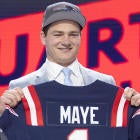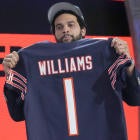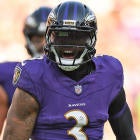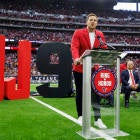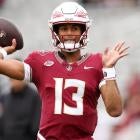Sports divorces can be messy. This is particularly true with an NFL team and a player that has been the face of franchise for an extended period of time.
The NFL’s annual spring meetings ended Wednesday with Tony Romo still a member of the Dallas Cowboys despite owner Jerry Jones publicly stating in early March he was going to abide by a “Do Right” rule for his longtime quarterback’s departure. The expectation was Romo, who has a $24.7 million salary cap number and a $14 million salary this year, would be released with a post-June 1 designation once the 2017 league year began March 9.
The $19.6 million salary cap charge relating to the bonus proration in Romo’s 2013 extension and the subsequent contract restructurings for cap purposes in 2014 and ‘15 would be taken over the next two years with a post-June 1 designation. The Cowboys would be required to carry Romo’s full cap number until June 2, when his $14 million 2017 salary would come off their cap, leaving a $10.7 million cap charge for this year. Romo would remain on the Cowboys’ books in 2018 with an $8.9 million cap charge.
Almost a month later, Romo’s status hasn’t changed. Jones is still holding onto Romo, which is well within his rights, in hopes of getting some sort of draft pick from a quarterback-needy team like the Texans or Broncos. Announcing this “Do Right” rule, to which Jones is giving lip service, isn’t helping trade efforts. A trade market hasn’t and is unlikely to materialize because teams hardly ever give up anything of value when they expect a player to be released.
Jones clarified his Romo timetable Tuesday. He anticipates a resolution with Romo before the start of training camp in late July. This date could just be posturing for trade purposes, which other teams should easily see through. Considering Jones keeps moving the goal line, there isn’t anything preventing him from keeping Romo deep into preseason just in case there’s a significant injury to a starting quarterback, like the Vikings had with Teddy Bridgewater last year. Romo’s contract doesn’t contain a roster bonus or guarantees vesting on a specific date, which probably would have forced the Cowboys to make a decision by now. In all fairness, a contract signed in 2013 shouldn’t be expected to have these kinds of mechanisms four years into the deal.
How it should end
A logical ending point to Romo’s days in Dallas should be April 17. It’s the start of the Cowboys’ offseason workout program. If Romo is still under contract to the Cowboys at this time, he needs to seriously consider playing the hand he has been dealt by using the tools at his disposal to try to accelerate his departure from the Cowboys. That is, if his goal is to play football next season.
If so, he is going to want as much time as possible to learn a new offensive system with another team and develop chemistry with new receivers. Romo probably doesn’t want to end his career as a backup after looking pretty sharp leading the Cowboys to a touchdown in his lone drive against the Eagles during the regular-season finale, which was his first real game action since Week 12 in 2015.
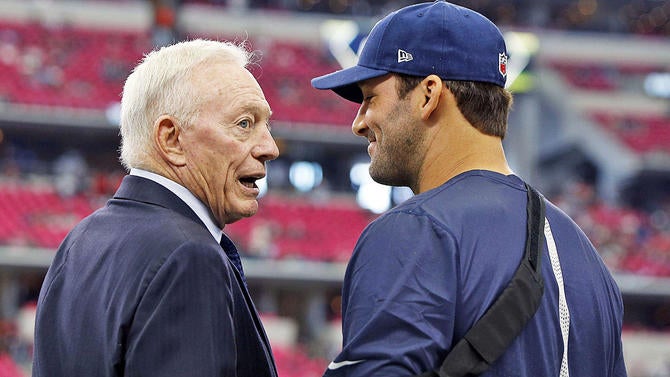
As long as Romo plans on playing football in 2017, he should show up for the Cowboys’ offseason program when it begins with the intention of participating. Although workout programs and organized team activities are voluntary, he would be fulfilling the conditions of his contract even though it isn’t expected to be in existence when regular-season games begin.
Paragraph 26 of his 2015 contract is titled, “2016-2019 Non-Performance De-escalator.” Romo’s base salary will decrease by $500,000 in any season that he doesn’t complete at least 90 percent of the total scheduled workouts in the offseason program, fully participate in offseason minicamp(s) and training camp as well as honor all other contractual obligations up until the Tuesday before the first regular-season game of that particular year. This type of de-escalator is routinely a part of the most lucrative Cowboys contracts, such as those signed by Dez Bryant, Travis Frederick and Tyron Smith.
What Cowboys risk by keeping Romo
The Cowboys shouldn’t want Romo participating in any of their offseason activities since he isn’t expected to be on the roster once the season starts. A serious injury could put the Cowboys on the hook for his entire $14 million salary and $24.7 million cap number.
Besides the financial liability, Romo’s presence could be awkward for his teammates and coaches. Reports surfaced last week that Romo’s heartfelt speech to the media last November where he conceded the starting quarterback job to Dak Prescott, the eventual 2016 NFL Offensive Rookie of the Year, created a rift between him and head coach Jason Garrett. Once close, Romo and Garrett haven’t spoken since the season ended. Reports from this week have Romo distancing himself from teammates and coaches that are big supporters of Prescott.
Precedent isn’t on the Cowboys’ side if Romo is prevented from being a part of the workout program and OTAs. The NFL Players Association won a grievance against the Titans in 2006 for breach of contract and violating the collective bargaining agreement after quarterback Steve McNair was barred from working out at their facility. The NFLPA’s position was that McNair should be allowed to work out at the Titans’ premises or be released. McNair was under contract for $10 million with a $23.46 million cap number while the Titans were expected to take a quarterback with the third overall pick in the 2006 NFL Draft. The Titans used the pick on Vince Young. McNair was traded to the Ravens that June shortly after the arbitrator rendered his decision.

The NFLPA intervened on quarterback Daunte Culpepper’s behalf in June 2007 when he was prevented from participating in the Dolphins’ minicamp because the team was trying to trade him and didn’t want be liable for his contract if he suffered a setback in his recovery from knee surgery. Culpepper’s release was sought by the NFLPA through an expedited grievance, which would probably be pursued in a Romo case. Unlike the Titans, the Dolphins allowed Culpepper to work out at their facilities. Culpepper was released in the middle of July a day before his grievance was scheduled to be heard, so the issue of whether a team has the right to keep out a healthy player who wants to participate in offseason practices hasn’t been settled.
Romo’s nuclear option
Additional steps could be taken by Romo to give Jones the drama he seems to enjoy stirring up. Romo was the consummate professional in how he handled his demotion last year. He could start taking a different approach after showing up for workouts.
As an agent, I was involved in a couple of protracted contract disputes where players considered true professionals, Keenan McCardell and Jimmy Smith, took actions that were out of character in order to achieve a desired result. Unfortunately, this is how the business of the NFL can work with players perceived as “nice guys” because kindness can get mistaken as weakness by teams.

For starters, Romo could up the ante by reading another prepared statement to the media or holding a press conference where he requests an opportunity to compete with Prescott to start since he never lost his job because of his own performance. A way to do this where Romo could have plausible deniability is for his representatives at Creative Artists Agency to make these types of statements about his situation, which would give him the option of distancing himself from their position. It’s something Eli Manning did a couple of years ago when he was rumored to be asking the Giants to make him the league’s highest-paid player during negotiations of his four-year, $84 million extension. Either way, this could become an unwanted distraction for Romo’s teammates and coaches.
Outwardly acting as a disgruntled player to give his teammates and coaches a preview of what life could be like with Romo still around would be taking it to another level. Doing any of these things doesn’t seem likely because Romo appears to value his relationship with Jones too much to create any acrimony.
Don’t expect Romo to renegotiate his contract to a lower salary to help facilitate a trade as some have suggested. The remaining $54 million over the next three seasons is actually a reasonable amount for a starting quarterback. Mike Glennon, an unproven commodity who has thrown just 11 passes over the past two seasons, signed a three-year, $45 million contract with the Bears in free agency. His first-year salary is $16 million.
In 2016, the average yearly salary for a starting quarterback on a veteran contract was just above $19.475 million, which is close to a 13 percent increase from 2015’s $17,283,333 number. This figure is expected to go up for 2017 with Derek Carr, Kirk Cousins, Matt Ryan and Matthew Stafford potentially receiving long-term contracts that should exceed Andrew Luck’s $24.594 million per year, which makes him the NFL’s highest-paid player.
The Cowboys really should bring the Romo saga to an end before the start of offseason workouts April 17. At the very latest, Romo should be let go if a trade doesn’t materialize by the time the draft ends on April 29. Jones needs to ask himself whether the ends would justify the means if he sticks with the stated training camp timetable. There’s just too much potential for more harm than good to occur the longer the situation continues.













